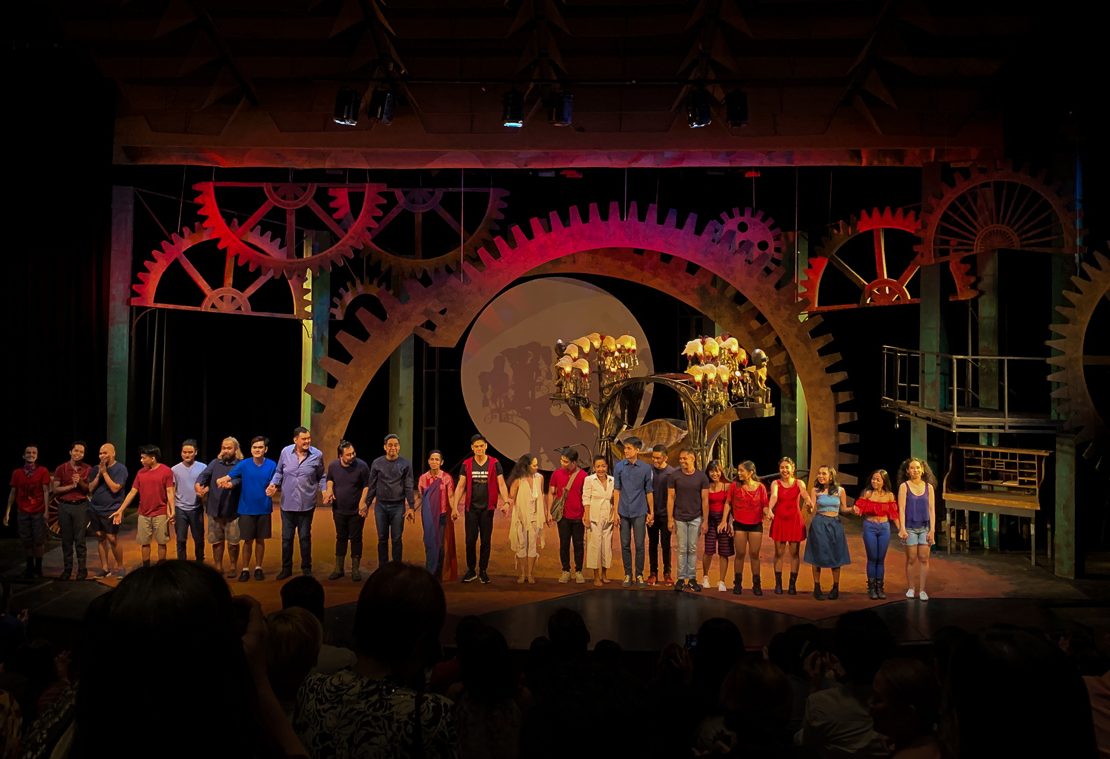I’m all about social relevance, but I certainly didn’t expect I’d be raising my fist in the middle of a theater—one as prestigious as the Cultural Center of the Philippines’ (CCP) Tanghalang Aurelio Tolentino, at that—as if I were at a mobilization on the streets.
I also didn’t think I’d be exiting the theater chanting “artista ng bayan, ngayon ay lumalaban!” along with the cast.
But that’s exactly what happened after I had gone to see Tanghalang Pilipino’s fourth restaging of Mabining Mandirigma: A Steampunk Musical.
Opening Tanghalang Pilipino’s 33rd season themed “makidigma,” Mabining Mandirigma is, put simply, the story of Apolinario Mabini—the man who, despite being credited as the brain of the revolution, also remains to be shrouded in mystery and, in modern parlance, “fake news.” (Remember all the “bakit laging nakaupo si Mabini?” questions after Heneral Luna and Goyo: Ang Batang Heneral?)
But it’s not just a simple musical retelling. Written by Nicanor Tiongson and set to music by Joed Balsamo, Mabining Mandirigma puts the hero’s story—and our country’s history—through the imaginative lens of steampunk coupled with non-traditional casting.
The steampunk aspect is most evident in the set (by Toym Imao) and costume design (by the late James Reyes). Gears frame the stage with a gigantic clock’s face as the centerpiece, doubling as a projection screen. As the play begins, the gears (by light and shadowplay) turn, smoke envelops the stage, and key points in the Philippine revolution flash on screen—almost as if stepping into a time machine.
The late Reyes earned the play a Philstage Gawad Buhay award for Outstanding Costume Design in 2015 for the steampunk costumes he had designed, which to this day remains a fine example of the marriage of aesthetic and meaning. Note the ilustrados and other Filipinos in blacks and browns, all decked out in steampunk accessories, the Americans mostly half-clothed (does this symbolize their supposed liberal mindset?)—and then Mabini, in stark contrast with his simple white ensemble.
(Read: Designer James Reyes passes away at 48)
Mabini is made to stand out, not just visually, but vocally, too. Mabining Mandirigma is non-traditional in this sense, purposefully choosing to cast women for the title role despite the character being male. The reason for this, director Chris Millado shares, is to emphasize Mabini being othered—for his condition, his status, and eventually his ideas. Not only does his voice need to rise above the rest of the characters, a woman would also best represent the idea of being othered, sharing the same experience of exclusion during that time period.
Actress and activist Monique Wilson—who interestingly was who the creative team first had in mind to play the role of Mabini upon the musical’s inception years ago—takes on the role of Mabini. Here she displays impressive acting chops as, unlike the rest of the cast, she is mostly confined to a wheelchair or hammock, and thus must make use of only her facial expressions and voice to convey the emotions and passion of Mabini. Returning to the stage as Mabini and alternating for Wilson is Hazel Maranan, who is also actually related to Mabini in real life.
Tenors Arman Ferrer and David Ezra also reprise their roles as Emilio Aguinaldo. Both giving powerfully charged counterpoints to Mabini, vocally and ideologically as the play progresses.
The retelling of history in the musical remains pretty much true to what we (now) know, but what’s interesting is how Mabining Mandirigma creatively presents them on stage. The silliness of the scenes involving Americans, for example, may seem jarring at first, but totally make sense—the Americans never did take us seriously then.
The meeting of Mabini and Aguinaldo, and how they begin to work together to create the Philippines’ new government, and the subsequent move to Malolos, demonstrates a beautiful harmony between Mabini’s alto and Aguinaldo’s tenor. But the introduction of the mischievous, merry-making ilustrados breaks this harmony, and eventually we hear Aguinaldo literally take on a different tune as he starts getting “hypnotized” (with the ilustrados’ entrancing dance with LED pin lights—at first jarring, but understandable, I suppose) by their ideas.
(On a more personal note, I love the ilustrados’ song. I don’t agree with them, but I like their song.)
Another show stopping number is that of Pepe, Mabini’s caregiver, rapping about the plight of the peasant class—mga binusabos—after a short, comical discussion with Mabini about the Malolos Convention’s ostentatious French dinner.
All music stops at the discussion of the constitution—the musical silence highlighting the gravity of the argument between Mabini and the ilustrado-led Congress.
Other noteworthy details abound in the musical: from the opening notes of the National Anthem injected into several songs, to the sign language inserted into the choreography (which is actually a direct translation of the lyrics of the song it was used in, “Mahalin Mo Ang Pilipinas.”)
The journey of Mabini as a warrior—despite his status and condition, and in the face of opposition—is also marked by heartrending songs. From young Pule (Phi Palmos) convincing his mother to let him pursue his studies in Manila (to which she replies with a painful truth: “mapait na sumpa ang maging marunong”), to adult Mabini’s frustrations with the fledgling Filipino nation, in the wake of Antonio Luna’s death (“mahirap ba mag-isip bilang Pilipino?” he asks).
In the end, the cast brings the whole journey back to the present, describing what ideas Mabini would have stood for if he were alive today: he wouldn’t allow other nations to encroach into our territory and sovereignty, he wouldn’t accept extrajudicial killings, he would denounce sexism. It brings the audience to roaring applause and cheers.
It may seem off-putting at first, but it tugs at your being a Filipino—how can you say no, now?
Mabining Mandirigma runs at Tanghalang Aurelio Tolentino, Cultural Center of the Philippines, until Sept. 1.
Get more stories like this by subscribing to our weekly newsletter here.
Read more:
Filipino epic “Ibong Adarna” gets a new English staging by Repertory Philippines
A little lesson on life from a little girl asking “Why is cancer?”
Someone said Rak of Aegis shouldn’t get a rerun anymore, and I have a lot of words
Writer: PAULINE MIRANDA




